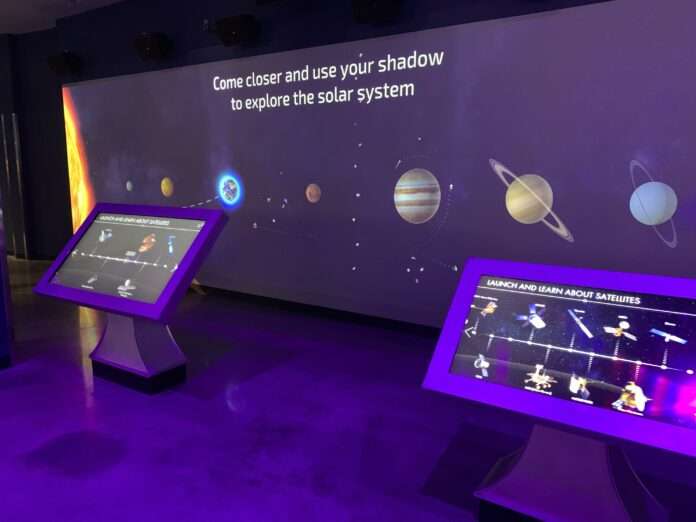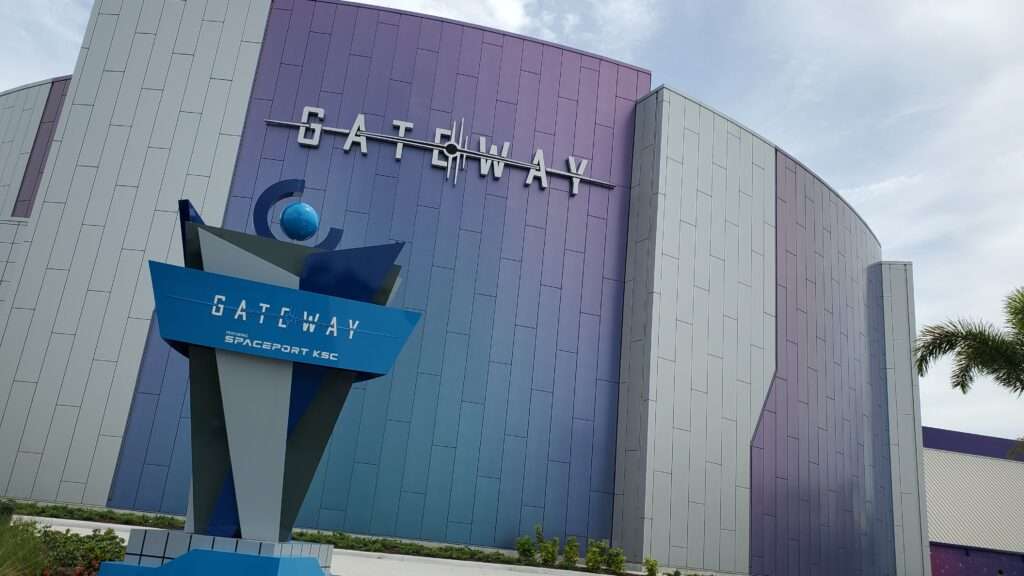Blue Telescope helps Kennedy Space Center Visitor Complex guests explore deep space
by David Edmonds
How do you inspire the next generation of dreamers and adventurers to face the challenges of interplanetary exploration? You build an attraction with a peek into the future of deep space travel, naturally.
Gateway™: The Deep Space Launch Complex, the newest experience at Kennedy Space Center Visitor Complex, opened June 15, 2022. It celebrates the present and future of collaborative space exploration, including NASA’s partnerships with Aerojet Rocketdyne, Boeing, Lockheed Martin, SpaceX, Sierra Space, and ULA, showcasing next-generation spacecraft launching to the moon, Mars and beyond.
In the style of contemporary, interactive attractions, guests are engaged with one-of-a-kind experiences, artifacts, exhibits, entertainment and education in the 50,000-square-foot, multilevel attraction. At Spaceport KSC, guests are transported to an airport of the future, hearing the atmospheric airport chatter and seeing distant views of active launches and landings through the galactic spaceport windows. Guests then board “spaceships” – in the form of a two-story, motion theater – for one of four journeys: Cosmic Wonders, Daring Explorers, Red Planet or Uncharted Worlds. Each distinct destination allows for the possibility of a different experience with each visit.
For two exhibits that posed unique challenges, Kennedy Space Center Visitor Complex turned to the storytellers at award- winning NYC/Orlando-based experience design firm Blue Telescope. Their small-but-mighty team of creatives and developers were tasked to dream big for the RL10 engine display and the Robotic Space Explorers Interactive Wall within Gateway.
Founded in 2001, Blue Telescope has built a portfolio of audience-focused, engaging, interactive, themed experiences with state-of-the-art technology in museums, theme parks and corporate spaces. The company’s motto of “Expanding the Human Experience” was an apt North Star for the Gateway project’s goals. And with a name like Blue Telescope, how could they not embrace space?
“The exploration of deep space is a fantastic story,” said Trent Oliver, Blue Telescope Founder and Managing Director. “And a story this important needs to be told through unique experiences.”
A deliberate challenge
Inside Gateway’s free-flowing, two-story, interactive exhibit space, guests can come face-to-face with models of rockets, sit inside a capsule simulator, and engage with interactive displays to learn more about flight flown spacecraft.
Other exhibits allow guests to explore the next generation of spacesuits or learn about the challenges of spaceflight. Here, Blue Telescope was tasked to help guests understand how the journey into deep space is filled with many small steps towards a larger goal – with success or failure riding on each step.
Built around the RL10 engine, the “workhorse” of the past 50 years of space travel, Blue Telescope created an exhibit where guests must light a second stage booster and move their spacecraft out of low-Earth orbit. But where most exhibits would encourage guests to press a button, create an outcome and move on, Blue Telescope created an experience that challenged guests. “This is deliberately hard,” says Judith Zissman, Executive Creative Director for Blue Telescope. “After all, it’s actually rocket science.”
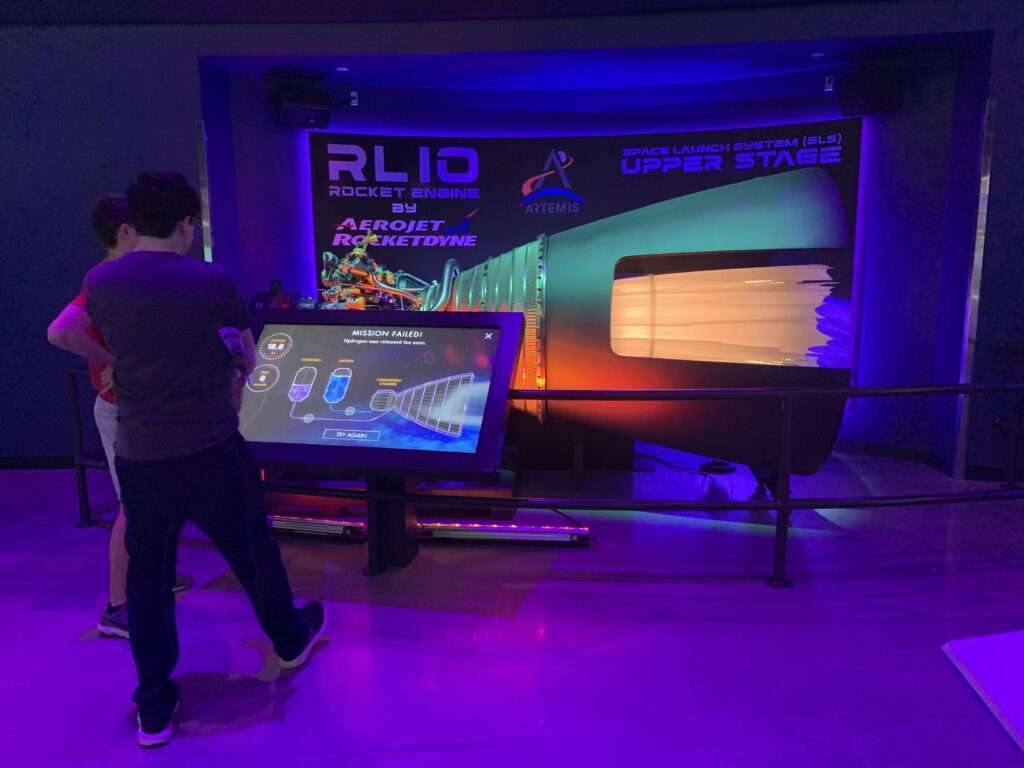
To successfully light the engine, guests must follow the instructions of launch control, mixing the fuel and igniting combustion at the precise moment. As an experience it is challenging, requiring a certain degree of focus to succeed, mimicking the under-pressure experience of being on a mission team. Guests who don’t complete each step of the game with precision are met with the sputter of an engine and mission failure. However, when successful, guests are rewarded with the roaring sound of the engine as it comes to life with a bright burst of stylized, scenic flame. This unique outcome was created through a combination of audio, LED lighting and scenic, cleverly integrated with a real RL10 engine.
The RL10 engine is one of the unique links between the past and future of space travel. First developed in the 1950s, it is still in use in several next-generation, deep space rockets. For Blue Telescope, using a real RL10 engine added a level of authenticity to the experience. It also required unique creative solutions during design and fabrication. As the modern engine is still a proprietary design, they had to turn to the public domain for engine documentation – in this case, an engine manual from 1964 – to aid in the creation of the exhibit.
Inspiring intrepid explorers
Some of humankind’s most important celestial discoveries have come from robotic satellites and probes that don’t always have household recognition or an emotional connection for viewers. The Robotic Space Explorers Interactive Wall on the second floor of Gateway seeks to change that.
This exhibit showcases just 40 (of the over 400) satellites and probes launched since the 1960s (including offering a glimpse into future missions). Initially envisioned as a video wall, Blue Telescope elevated the experience to an interactive and playful gesture-based adventure, creating engagement with guests as they move through the solar system alongside each spacecraft.
From a satellite kiosk, guests can pull up a mission and learn about it before “launching” it to the interactive media wall along its actual, accurate trajectory from Earth. As it travels across the wall, guests can reach out to “catch” the spacecraft, highlighting facts about the mission and destination and revealing playful “Easter eggs” with additional, behind-the-scenes stories about some of the most interesting robotic explorers.
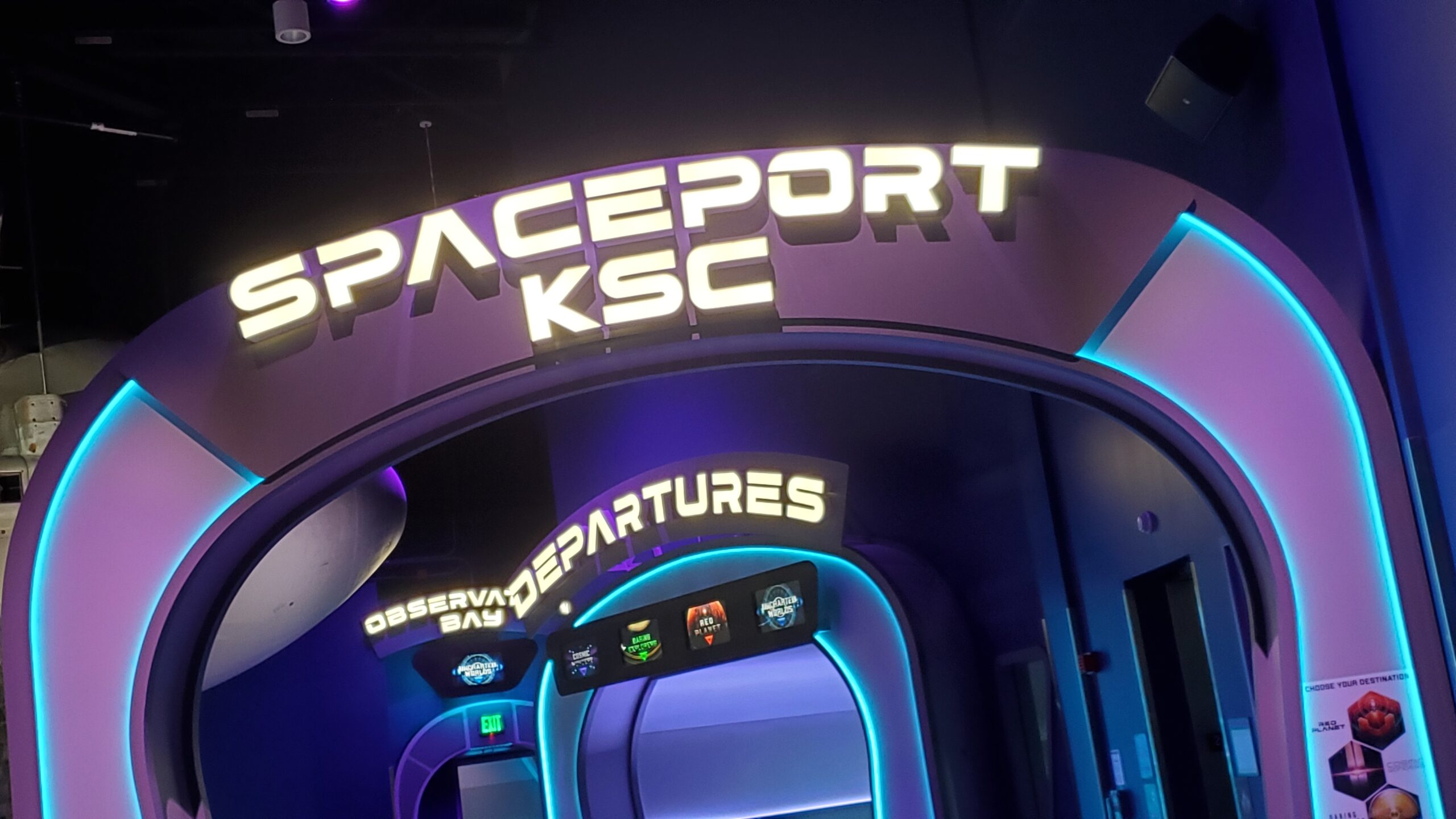
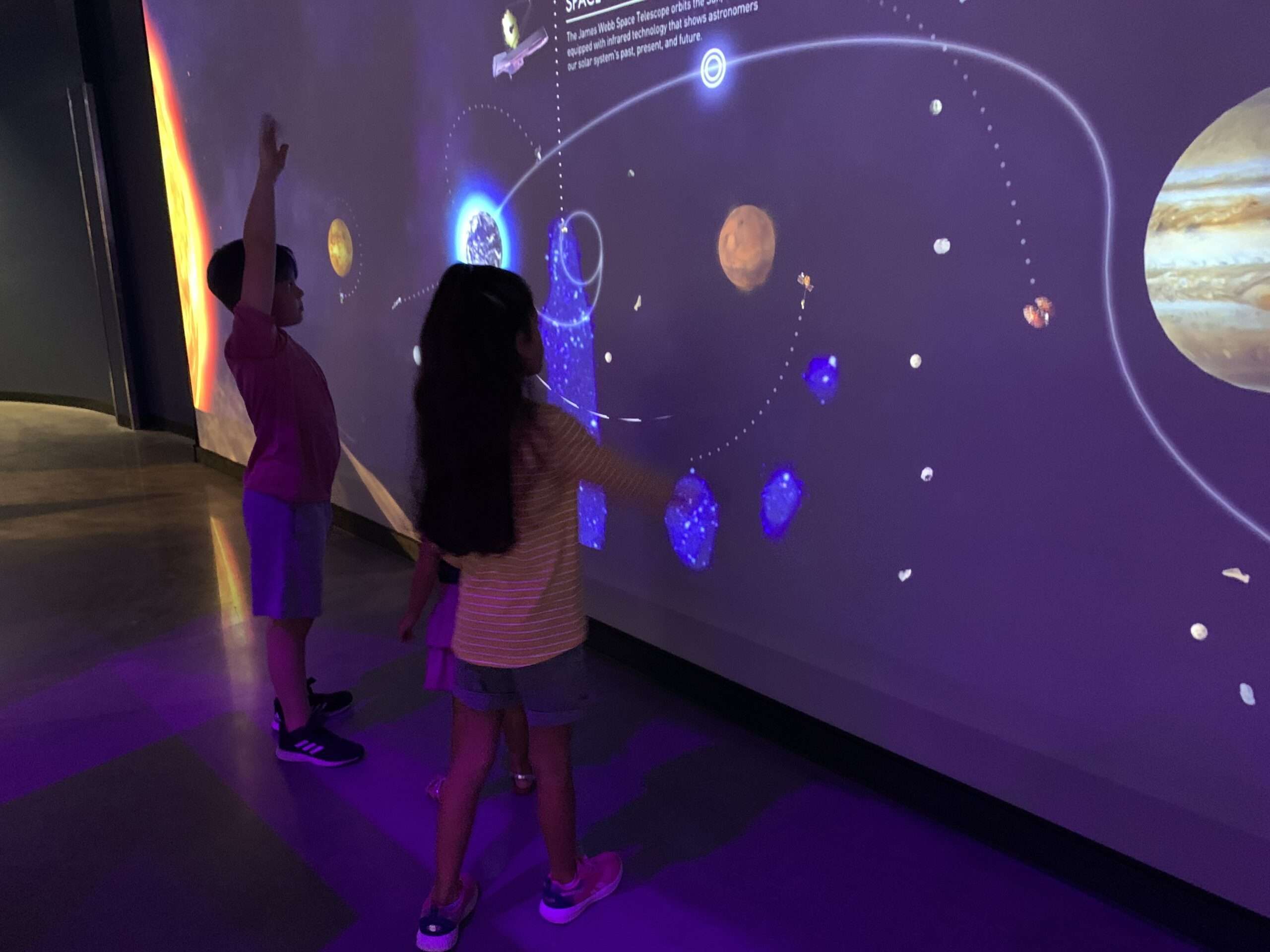
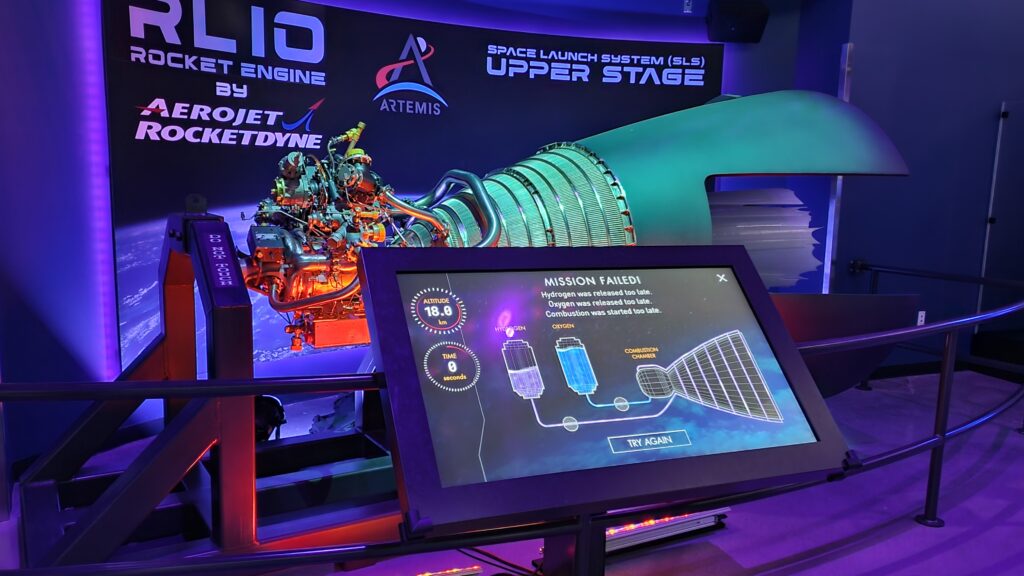
For Blue Telescope, each of these satellites represents a unique character in the story of deep space exploration. Giving guests insight into the traits and purpose behind each mission was a key goal. “To develop this experience, we had the opportunity to work directly with mission teams and each of us found we had a favorite satellite,” says Zissman. “I want guests to come away finding their own favorites as well.”
From weather satellites that orbit Earth to deep space probes visiting our solar system’s planets and beyond, the exhibit highlights how specialized each mission is, with the media content distilling the stories of these complex, multi-year projects to just a snapshot of their journeys. Select missions include secret nods hidden in the media for guests to unlock (hint: interact with the flight trajectory).
The exhibit focuses on education through dynamic play, striving to be intuitive and fresh. Blue Telescope created an immense amount of content for the experience with room for more. The media system is scalable and adaptable; as new missions make new discoveries, the experience can be expanded. By offering the option to add new information for future missions, the exhibit serves as a veritable interactive encyclopedia of satellites.
An amazing collaboration
“For Blue Telescope, our goal is that each experience will surprise and delight guests,” says Oliver. The Gateway project was an opportunity to dream big, working with Therrin Protze, COO for Kennedy Space Center Visitor Complex, and his team, and being encouraged to innovate and experiment. “Therrin and his team were perfect clients with which to push the envelope,” she says. “If we presented new ideas on how to improve the guest experience, their answer was often ‘let’s do it.’”
When a global pandemic created changes in the project’s schedule, the Blue Telescope team embraced the opportunity to experiment with new technologies to improve the guest experience. Already comfortable with working remotely, the team quickly adapted to workflow changes, collaborating with the project team and vendors virtually at first, then on-site in the later months of the project.
Ultimately, the success of the project came from the passion of Blue Telescope’s team, and this shows in the final product. “Space is the dream IP to get to work with,” says Zissman with obvious passion. “We’re ecstatic to have taken part in this project.” • • •
David Edmonds is a creative director and entertainment designer from Orlando, Florida. He is a passionate believer in themed entertainment – what it means, how important it is, and how it connects with guests. David has worked on numerous attractions and experiences around the world and loves to share a designer’s perspective on the industry through writing and speaking for industry groups.


